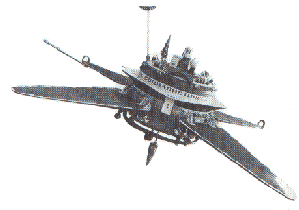|
|
Prognoz 6

The SIGNE program (Solar International Gamma-Ray and
Neutron Experiments) was a joint French-Soviet program which first went into
space in 1972 with the Prognoz 2 satellite. The scientific objectives of all of
the Prognoz missions was the study of particles and fields and solar
electromagnetic radiation. Prognoz 6 was launched from the USSR on 22 September
1977 into a highly elliptical orbit (~200,000 km x 500 km). The orbital
inclination was 65 degrees. The orbital period was about 4 days, with most of
the time spent outside of the Earth's magnetosphere. The satellite weighed
about 900 kg, and was spin stabilized with a period of ~120 seconds. The spin
axis was updated periodically in order to keep the angle between the spin axis
and the Sun to less than 8 degrees. Useful data was collected until March 1978
when the satellite lost stability control.
Prognoz 6 carried the French SIGNE II MP experiment, designed primarily to
study solar X- and gamma- radiation and cosmic gamma-ray bursts. A secondary
objective was the study of discrete cosmic X-ray sources. The experiment
consisted of 3 detectors: an omnidirectional upper detector in a plastic
anticoincidence shield which faced the Sun, an actively collimated lateral
detector also pointed toward the Sun, and an actively collimated lateral
detector pointed toward the anti-Sun. The two collimated, lateral detectors
were used primarily for the observation of discrete sources, while the upper,
omnidirectional detector was used for bursts. The axis of the upper detector
is parallel to the satellite spin axis. The axis of the lateral detectors
was 9.5 degrees away from the spin axis, in order to create a roll modulation
for discrete source observations.
The dedicated gamma-ray burst detector, i.e. the upper detector, faced in
the direction of the Sun. It was a 4.5 cm radius by 3.7 cm thick NaI(Tl)
crystal, surrounded by an 8 mm thick plastic anticoincidence jacket. The
crystal and the plastic were viewed from the side by photomultipliers. The
gamma-ray burst detector operated in low time resolution "waiting" modes in the
absence of a burst; low energy resolution spectra and higher energy resolution
calibration spectra were transmitted in this mode. Typically, the data were
accumulated into 163.8 s time bins, 1-31 energy channels. Detection of a burst
triggered the storage of high time resolution count rates and spectral data.
The trigger criterion was an excess count rate 8 sigma above normal in a 250 ms
interval. The maximum time resolution was 1/512 s. The energy ranges examined
for burst detection ranged from 20-280 keV to 80-3000 keV, depending on the
detector mode. During a burst, there were 1-6 energy channels used, and, for
Prognoz 6 and a "typical" burst, the nominal energy range was 80-400 keV. The
total data rate for the Prognoz 6 experiment package was 6 b/s.
The SIGNE II MP experiment on Prognoz 6 detected 3 confirmed gamma-ray
bursts (20 Oct 1977; 29 Oct 1977; 10 Nov 1977) and four additional candidate
events.
[Gallery]
[Publications]
[All Missions]
[by Time]
[by Energy]
Page authors: Lorella Angelini Jesse Allen
HEASARC Home |
Observatories |
Archive |
Calibration |
Software |
Tools |
Students/Teachers/Public
Last modified: Thursday, 26-Jun-2003 13:48:16 EDT
HEASARC Staff Scientist Position - Applications are now being accepted for a Staff Scientist with significant experience and interest in the technical aspects of astrophysics research, to work in the High Energy Astrophysics Science Archive Research Center (HEASARC) at NASA Goddard Space Flight Center (GSFC) in Greenbelt, MD. Refer to the AAS Job register for full details.
|


